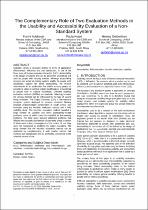 ResearchSpace
ResearchSpace
Complementary role of two evaluation methods in the usability and accessibility evaluation of a non-standard system
JavaScript is disabled for your browser. Some features of this site may not work without it.
- ResearchSpace
- →
- Research Publications/Outputs
- →
- Conference Publications
- →
- View Item
| dc.contributor.author |
Adebesin, F

|
|
| dc.contributor.author |
Kotzé, Paula

|
|
| dc.contributor.author |
Gelderblom, H

|
|
| dc.date.accessioned | 2010-12-06T11:22:41Z | |
| dc.date.available | 2010-12-06T11:22:41Z | |
| dc.date.issued | 2010-10 | |
| dc.identifier.citation | Adebesin, F, Kotzé, P and Gelderblom, H. 2010. Complementary role of two evaluation methods in the usability and accessibility evaluation of a non-standard system. SAICSIT 2010: 2010 Annual Research Conference of the South African Institute for Computer Scientists and Information Technologists, Bela Bela, South Africa, 11-13 October 2010 , pp 1-11 | en |
| dc.identifier.isbn | 978-1-60558-950-3 | |
| dc.identifier.uri | http://hdl.handle.net/10204/4599 | |
| dc.description | SAICSIT 2010: 2010 Annual Research Conference of the South African Institute for Computer Scientists and Information Technologists, Bela Bela, South Africa, 11-13 October 2010 | en |
| dc.description.abstract | Usability, which is generally defined in terms of application effectiveness, efficiency and user satisfaction, is one of the focus areas of human-computer interaction (HCI). Accessibility is the design of systems that can be perceived, understood and used by people with varying abilities. Although accessibility concerns are aimed at making systems usable for people with disabilities, support for direct accessibility, the built-in redundancies in an application that enable as many people as possible to utilize it without system modifications, is beneficial to people with or without disabilities. Different usability evaluation methods (UEMs) are available. Selecting between the various methods can be influenced by the type of system being evaluated. The Digital Doorway (DD), a non-standard computer system deployed to promote computer literacy amongst underprivileged communities in South Africa, was evaluated using the heuristic evaluation method and a field usability study. The heuristic evaluation method revealed a large number of usability and direct accessibility-related problems, some of which could be classified as low-severity problems. The field study showed additional problems that affected the successful completion of user tasks. Since a number of these were a direct consequence of the context of use, they were not recognized as problems by expert evaluators. The study showed that the heuristic evaluation method can be optimized by complementing it with another method that involves user participation and is, preferably, carried out in the intended context of use. | en |
| dc.language.iso | en | en |
| dc.publisher | Association for Computing Machinery | en |
| dc.relation.ispartofseries | Conference Paper | en |
| dc.subject | Heuristic evaluation | en |
| dc.subject | Computer science | en |
| dc.subject | Information technologists | en |
| dc.subject | Digital doorway | en |
| dc.title | Complementary role of two evaluation methods in the usability and accessibility evaluation of a non-standard system | en |
| dc.type | Conference Presentation | en |
| dc.identifier.apacitation | Adebesin, F., Kotzé, P., & Gelderblom, H. (2010). Complementary role of two evaluation methods in the usability and accessibility evaluation of a non-standard system. Association for Computing Machinery. http://hdl.handle.net/10204/4599 | en_ZA |
| dc.identifier.chicagocitation | Adebesin, F, Paula Kotzé, and H Gelderblom. "Complementary role of two evaluation methods in the usability and accessibility evaluation of a non-standard system." (2010): http://hdl.handle.net/10204/4599 | en_ZA |
| dc.identifier.vancouvercitation | Adebesin F, Kotzé P, Gelderblom H, Complementary role of two evaluation methods in the usability and accessibility evaluation of a non-standard system; Association for Computing Machinery; 2010. http://hdl.handle.net/10204/4599 . | en_ZA |
| dc.identifier.ris | TY - Conference Presentation AU - Adebesin, F AU - Kotzé, Paula AU - Gelderblom, H AB - Usability, which is generally defined in terms of application effectiveness, efficiency and user satisfaction, is one of the focus areas of human-computer interaction (HCI). Accessibility is the design of systems that can be perceived, understood and used by people with varying abilities. Although accessibility concerns are aimed at making systems usable for people with disabilities, support for direct accessibility, the built-in redundancies in an application that enable as many people as possible to utilize it without system modifications, is beneficial to people with or without disabilities. Different usability evaluation methods (UEMs) are available. Selecting between the various methods can be influenced by the type of system being evaluated. The Digital Doorway (DD), a non-standard computer system deployed to promote computer literacy amongst underprivileged communities in South Africa, was evaluated using the heuristic evaluation method and a field usability study. The heuristic evaluation method revealed a large number of usability and direct accessibility-related problems, some of which could be classified as low-severity problems. The field study showed additional problems that affected the successful completion of user tasks. Since a number of these were a direct consequence of the context of use, they were not recognized as problems by expert evaluators. The study showed that the heuristic evaluation method can be optimized by complementing it with another method that involves user participation and is, preferably, carried out in the intended context of use. DA - 2010-10 DB - ResearchSpace DP - CSIR KW - Heuristic evaluation KW - Computer science KW - Information technologists KW - Digital doorway LK - https://researchspace.csir.co.za PY - 2010 SM - 978-1-60558-950-3 T1 - Complementary role of two evaluation methods in the usability and accessibility evaluation of a non-standard system TI - Complementary role of two evaluation methods in the usability and accessibility evaluation of a non-standard system UR - http://hdl.handle.net/10204/4599 ER - | en_ZA |





